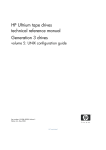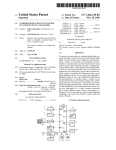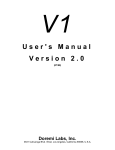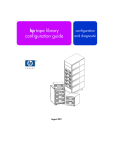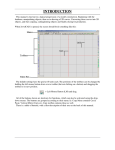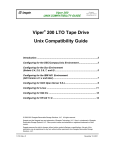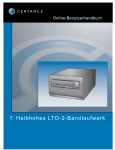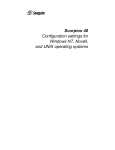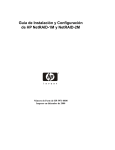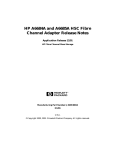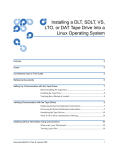Download HP Ultrium Tape Drive User's Manual
Transcript
HP Ultrium tape drives Technical reference manual Generation 3 drives Volume 5—Unix configuration guide Part number: Q1538–90925 Volume 5 Edition 6.1, December 2004 <Bold Header> Legal and notice information © Copyright 2004—Hewlett-Packard Development Company, L.P. The information contained in this document is subject to change without notice. Hewlett-Packard makes no warranty of any kind with regard to this material, including, but not limited to, the implied warranties of merchantability and fitness for a particular purpose. Hewlett-Packard shall not be liable for errors contained herein or direct, indirect, special, incidental or consequential damages in connection with the furnishing, performance, or use of this document. This document contains proprietary information which is protected by copyright. All rights reserved. No part of this document may be photocopied, reproduced or translated to another language without the prior written consent of Hewlett-Packard. Revision history Version Date Changes Edition 6 September 2004 Generation 3 SCSI and FC drive version Edition 6.1 December 2004 Reformatted and updated This document is frequently revised and updated. To find out if there is a later version, please ask your HP OEM Representative. <Bold Header> The purpose of this manual . . . . . . . . . . . . . . . . . . . . . . . . . . . . . . . . . . Related documents . . . . . . . . . . . . . . . . . . . . . . . . . . . . . . . . . . . . . . . . Documents specific to HP Ultrium drives . . . . . . . . . . . . . . . . . . . . . . . Documentation map . . . . . . . . . . . . . . . . . . . . . . . . . . . . . . . . . . . . . General documents and standardization . . . . . . . . . . . . . . . . . . . . . . ... ... ... ... ... ... ... ... ... ... .... .... .... .... .... ... ... ... ... ... . . . . . 5 5 5 5 8 1 Introduction The Purpose of this Manual . . . . . . . . . . . . . . . . . . . . . . . . . . . . . . . . . . . . . . . . . . . . . . . 11 Ultrium Drives in a Library. . . . . . . . . . . . . . . . . . . . . . . . . . . . . . . . . . . . . . . . . . . . . . 11 Backup Applications . . . . . . . . . . . . . . . . . . . . . . . . . . . . . . . . . . . . . . . . . . . . . . . . . . . . 11 2 HP-UX Systems HP Servers and Workstations—HP-UX 11.x Introduction. . . . . . . . . . . . . . . . . . . . Determining the SCSI ID . . . . . . . . . . . Creating the Device Files . . . . . . . . . . What Next? . . . . . . . . . . . . . . . . . . . . . . .......... .......... .......... .......... .......... ... ... ... ... ... ... ... ... ... ... .... .... .... .... .... ... ... ... ... ... ... ... ... ... ... ... ... ... ... ... .... .... .... .... .... ... ... ... ... ... 13 13 13 14 17 3 HP Alpha UNIX HP Alpha UNIX 5.x. . . . . . . . . . . . . . . . . . . . . . . . . . . . . . . . . . . . . . . . . . . . . . . . . . . . . 19 What Next? . . . . . . . . . . . . . . . . . . . . . . . . . . . . . . . . . . . . . . . . . . . . . . . . . . . . . . . 20 4 IBM (AIX) Determining the SCSI ID . . . . . . . . . . . . . . . . . . . . . . . . . . . . . . . . . . . . . . . . . . . . . . . . . 21 Configuring the Device Files. . . . . . . . . . . . . . . . . . . . . . . . . . . . . . . . . . . . . . . . . . . . . . . 21 5 Linux Determining the SCSI ID (Linux) . . . . . . . . . . . . . . . . . . . . . Configuring on Linux Systems . . . . . . . . . . . . . . . . . . . . . . . Using the Seek and Tell Features of mt . . . . . . . . . . . . . . What Next? . . . . . . . . . . . . . . . . . . . . . . . . . . . . . . . . . . . ... ... ... ... .... .... .... .... ... ... ... ... ... ... ... ... ... ... ... ... .... .... .... .... ... ... ... ... 23 23 25 25 6 Sun Systems, Solaris 8, 9, 10 Determining the SCSI ID . . . . . . . . . . . . . . . . . . . . . . . . . . . . . . . . . . . . . . . . . . . . . . . . . 27 Configuring the Device Files. . . . . . . . . . . . . . . . . . . . . . . . . . . . . . . . . . . . . . . . . . . . . . . 28 HP-Data Values . . . . . . . . . . . . . . . . . . . . . . . . . . . . . . . . . . . . . . . . . . . . . . . . . . . . . . . 29 Contents 3 Contents Contents 7 Verifying the Installation Verifying the Installation of the Drive (UNIX). . . . . . . . . . . . . . . . . . . . . . . . . . . . . . . . . . . . . 31 To verify the installation: . . . . . . . . . . . . . . . . . . . . . . . . . . . . . . . . . . . . . . . . . . . . . . . . 31 Example: . . . . . . . . . . . . . . . . . . . . . . . . . . . . . . . . . . . . . . . . . . . . . . . . . . . . . . . . 32 Glossary . . . . . . . . . . . . . . . . . . . . . . . . . . . . . . . . . . . . . . . . . . . 35 Index . . . . . . . . . . . . . . . . . . . . . . . . . . . . . . . . . . . . . . . . . . . . . 39 4 Contents The purpose of this manual This is one of six volumes that document HP Ultrium drives. This volume provides background information for driver and application developers. The following products are covered. Capacities are when the drive is using data compression with a compression ratio of 2:1, where applicable: • HP Ultrium Generation 3 Full-Height SCSI Internal Drive • HP Ultrium Generation 3 Full-Height FC Internal Drive NOTE: Throughout this manual frequent reference is made to SCSI commands. For more information on SCSI commands for HP Ultrium drives see volume 3, The SCSI Interface, of the HP Ultrium Technical Reference Manual set. Ordering details are given below. Related documents The following documents provide additional information: Documents specific to HP Ultrium drives • Hardware Integration Guide, volume 1 of the HP Ultrium Technical Reference Manual • Software Integration Guide, volume 2 of the HP Ultrium Technical Reference Manual • The SCSI Interface, volume 3 of the HP Ultrium Technical Reference Manual • Specifications, volume 4 of the HP Ultrium Technical Reference Manual • Background to Ultrium Drives, volume 6 of the HP Ultrium Technical Reference Manual Please contact your HP supplier for copies. • The features and benefits of HP Ultrium drives are discussed in the HP Ultrium Technology White Paper. • For a general background to LTO technology and licensing, go to http://www.ltotechnology.com. Documentation map The following will help you locate information in the 6-volume Technical Reference Manual: The purpose of this manual 5 Drives—general SCSI Drives Connectors Controller architecture Front Panel LEDs Mechanism and hardware FC Drives 1 HW Integration: ch. 7 1 HW Integration: ch. 4 6 Background: ch. 4 1 HW Integration: ch. 6 1 HW Integration: ch. 3 6 Background: ch. 3 Specifications 4 Specs Installation and configuration SCSI Drives FC Drives Connectors 1 HW Integration: ch. 7 1 HW Integration: ch. 4 Determining the configuration 2 SW Integration: ch. 2 2 SW Integration: ch. 2 External drives (SCSI only) 1 HW Integration: ch. 5 In Libraries n/a 1 HW Integration: ch. 1 In Servers (SCSI only) 1 HW Integration: ch. 4 n/a In Tape Arrays (SCSI only) 1 HW Integration: ch. 3 n/a Modes of Usage (SCSI only) 1 HW Integration: ch. 8 n/a Optimizing performance (SCSI only) 1 HW Integration: ch. 8 n/a 2 SW Integration: ch. 4 UNIX configuration 5 UNIX Config Operation External drives (SCSI only) In Libraries SCSI Drives FC Drives 1 HW Integration: ch. 5 n/a 1 HW Integration: ch. 1 In Servers (SCSI only) 1 HW Integration: ch. 4 n/a In Tape Arrays (SCSI only) 1 HW Integration: ch. 3 n/a SCSI Drives FC Drives Cartridges Cartridge Memory (LTO-CM) Cartridges 6 2 SW Integration: ch. 5 6 HW Integration: ch. 5 1 HW Integration: ch. 9 1 HW Integration: ch. 5 SCSI Drives FC Drives Features 6 HW Integration: ch. 5 Managing the use of cartridges 2 SW Integration: ch. 1 Use of cartridges 2 SW Integration: ch. 3 Interface SCSI Drives FC Drives SCSI Guide 3 SCSI Commands 3 SCSI: ch. 4 Error codes 1 HW Integration: ch. 10 1 HW Integration: ch. 6 Implementation 3 SCSI: ch. 1 Interpreting sense data 2 SW Integration: ch. 3 Messages 3 SCSI: ch. 2 Mode pages —see the MODE SENSE command 3 SCSI: ch. 4 Pre-execution checks 3 SCSI: ch. 3 Responding to Sense Keys and ASC/Q 2 SW Integration: ch. 6 Sense Keys and ASC/Q —see REQUEST SENSE command 3 SCSI: ch. 4 Maintenance and troubleshooting SCSI Drives Cleaning External drives (SCSI only) In Libraries FC Drives 2 SW Integration: ch. 5 2 SW Integration: ch. 7 1 HW Integration: ch. 5 n/a 1 HW Integration: ch. 1 In Servers (SCSI only) 1 HW Integration: ch. 4 n/a In Tape Arrays (SCSI only) 1 HW Integration: ch. 3 n/a Monitoring drive and tape condition 2 SW Integration: ch. 7 Software troubleshooting techniques 2 SW Integration: ch. 1 Dealing with errors SCSI Drives Error Codes FC Drives 1 HW Integration: ch. 10 1 HW Integration: ch. 6 Related documents 7 SCSI Drives Handling errors How error correction works FC Drives 2 SW Integration: ch. 5 6 Background: ch. 4 Logs—see the LOG SENSE command 3 SCSI: ch. 4 Recovering from write and read errors 2 SW Integration: ch. 7 Software response to error correction 2 SW Integration: ch. 3 Software response to logs 2 SW Integration: ch. 3 TapeAlert log 2 SW Integration: ch. 7 Ultrium features SCSI Drives Adaptive Tape Speed (ATS) FC Drives 6 Background: ch. 1 Autoload 1 HW Integration: ch. 2 Automation Control Interface (ACI) 1 HW Integration: ch. 2 Cartridge Memory (LTO-CM) 1 HW Integration: ch. 2 6 Background: ch. 1 2 SW Integration: ch. 5 6 HW Integration: ch. 5 Data Compression, how it works Data Compression, managing Design principles OBDR and CD-ROM emulation Performance optimization 6 Background: ch. 5 2 SW Integration: ch. 5 6 Background: ch. 1 6 Background: ch. 1 2 SW Integration: ch. 7 1 HW Integration: ch. 8 n/a 2 SW Integration: ch. 1 Performance, factors affecting 2 SW Integration: ch. 4 Software design 2 SW Integration: ch. 1 Supporting Ultrium features 2 SW Integration: ch. 5 Ultrium Format 6 Background: ch. 2 General documents and standardization • Small Computer System Interface (SCSI-1), ANSI X3.131-1986. This is the ANSI authorized standard for SCSI implementation, available through ANSI • Enhanced Small Computer System Interface (SCSI-2), ANSI X3T9.2-1993 Rev. 10L, available through ANSI 8 Copies of General Documents can be obtained from: ANSI 11 West 42nd Street New York, NY 10036-8002 USA ISO CP 56 CH-1211 Geneva 20 Switzerland ECMA 114 Rue du Rhône CH-1204 Geneva Switzerland Global Engineering Documents 2805 McGaw Irvine, CA 92714 USA Tel: +41 22 849 6000 Web URL: http://www.ecma.ch Tel: 800 854 7179 or 714 261 1455 Related documents 9 10 1 Introduction The Purpose of this Manual This manual provides basic information on configuring the drives with various operating systems. Please see the top-level release notes that accompany the drive for expected functionality and features. Ultrium drives are supported on the following platforms: • HP UNIX systems (HP-UX) (Chapter 2) Introduction • HP Alpha UNIX (Chapter 3) • IBM (AIX) (Chapter 4) • Linux (Chapter 5) • Sun Systems, Solaris 8, 9, 10 (Chapter 6) For platforms not mentioned here, please contact HP because there may be new connectivity details available that arrived after the release notes were published. See Chapter 7 for details of how to verify the installation. Ultrium Drives in a Library Ultrium drives may also be used in a library. However, instructions about installing device drivers for automatic robotics are not included in this manual. Backup Applications For optimum performance it is important to use a backup application that supports the drive’s features within your system’s configuration. Please see the “Getting Started Guide” for more information about usage models. The following applications are suitable for use within an enterprise environment and have been tested with Ultrium drives. They use the operating system’s standard, built-in device drivers, as The Purpose of this Manual 11 described in this manual. For further information about optimizing performance and making full use of the drive’s functions, please contact the software manufacturer or HP HP-UX AIX Sun, Solaris Linux Omniback1 yes yes yes yes Legato Networker yes yes yes yes Veritas NetBackup yes yes yes yes2 HP 1. Cell Manager is only available on HP-UX or Windows 2. Redhat Server only (not Caldera, Suse, and so on) 12 Introduction 2 HP-UX Systems HP Servers and Workstations—HP-UX 11.x NOTE: HP-UX 10.x is only supported by Generation 1 Ultrium drives. Introduction Before you install your tape drive log on to the HP web site, www.hp.com, and download the latest hardware enablement patch bundle for your operating system. This ensures that you will have the correct device driver for your tape drive. Determining the SCSI ID Before you configure your system to support your new HP Ultrium drive, you need to determine what SCSI ID to use. The SCSI ID must be unique for each device attached to the SCSI bus. To list the existing devices, use the following command: % /sbin/ioscan -f Class I H/W Path Driver S/W State H/W Type Description ================================================================================= bc 0 root CLAIMED BUS_NEXUS bc 1 8 bc CLAIMED BUS_NEXUS Psudo Bus Converter ba 0 8/0 GSCtoPCI CLAIMED BUS_NEXUS GSCtoPCI Bridge ext_bus 1 8/0/2/0 c720 CLAIMED INTERFACE SCSI C895 Ultra2 Wide LVD target 0 8/0/2/0.7 tgt CLAIMED DEVICE ctl 1 8/0/2/0.7.0 sctl CLAIMED DEVICE Initiator lan 0 8/0/20/0 btlan3 CLAIMED INTERFACE PCI(10110019) -- Built-in #1 ba 1 8/16 bus_adapter CLAIMED BUS_NEXUS Core I/O Adapter tty 0 8/16/4 asio0 CLAIMED INTERFACE Built-in RS-232C ext_bus 2 8/16/5 c720 CLAIMED INTERFACE Built-in SCSI target 1 8/16/5.5 tgt CLAIMED DEVICE disk 0 8/16/5.5.0 sdisk CLAIMED DEVICE SEAGATE ST34573N target 2 8/16/5.7 tgt CLAIMED DEVICE ctl 2 8/16/5.7.0 sctl CLAIMED DEVICE Initiator processor 0 62 processor CLAIMED PROCESSOR Processor memory 0 63 memory CLAIMED MEMORY Memory After you have installed the new tape drive, you can check that it has been attached successfully. From a shell window (hpterm/xterm), execute ioscan to display the list of attached devices. HP Servers and Workstations—HP-UX 11.x 13 HP-UX Systems The output of this should look similar to the following example: For an HP Ultrium drive, execute the following: % /sbin/ioscan -f | grep "Ultrium" The new lines should look similar to the following, where the 4 in the I field represents the instance of the SCSI tape driver, not the SCSI ID: tape 4 2/0/1.5.0 stape CLAIMED DEVICE HP Ultrium 3-SCSI NOTE: If you are installing the drive onto a Storage Area Network (SAN), the fibre channel/ SCSI bridge will also appear in the list of attached devices. If you cannot find the Ultrium drive, this may be because the kernel does not contain the correct driver. Use the System Administration Manager (sam) to add stape to the kernel: To add stape to the kernel using sam: 1. % sam 2. Select the following: Kernel Configuration Drivers 3. Highlight the stape driver. If the driver has not been added to the kernel, both Current State and Pending State will read “Out”. 4. Select the following: Actions Add Driver to Kernel The Pending State will now read “In”. 5. To add the new driver to the kernel, select: Actions Create a New Kernel 6. The stape driver will now be added to the kernel and then the system will reboot. Creating the Device Files Once you have verified the tape drive connection, you will need to create the appropriate device files for the drive. Normally, you would have rebooted your system after attaching the tape drive, and this process runs insf. However, if you have not rebooted your system since attaching the drive, you can create device files by one of two ways, either through the System Administration Manager (sam), or by executing the mksf command. To add device files using sam: This is the recommended and simplest way to create device files. 14 HP-UX Systems 1. % sam This will bring up the graphical user interface for the utility. 2. Select the following: Peripheral Devices Tape Drives sam will then scan the system for any tape drives connected. When an HP Ultrium Generation 3 drive is found, it will be displayed as: Hardware Path Driver Description =========================================================== 8/0/2/0.3.0 stape HP Ultrium 3-SCSI 3. Highlight the Ultrium drive and select the following from the tool bar: Actions Create Device Files Create Default Device Files This will create default device files for the drive. To view the device files that have been created, select: Actions Create Device Files Show Device Files where: Device File Description <I>m <I>mn <I>mb <I>mnb HP-UX Systems is the instance number of the drive: <I> AT&T encoding, rewind driver AT&T encoding, non-rewind driver Berkeley encoding, rewind driver Berkeley encoding, rewind driver is the card number, is the target number, is the LUN number: <X> <Y> <Z> cXtYbZBEST cXtYbZBESTb cXtYbZBESTn cXtYbZBESTnb Best Best Best Best compression compression compression compression driver, driver, driver, driver, AT&T encoding, with rewind Berkeley encoding, with rewind AT&T encoding, non-rewind Berkeley encoding, non-rewind 4. When you have exited sam, run ioscan to see the tape drive: %/sbin/ioscan -C tape -fn HP Servers and Workstations—HP-UX 11.x 15 To create device files using mksf: NOTE: This method is not recommended. 1. Run insf as follows: % /sbin/insf -C tape 2. Create the device files for the devices using the mksf command as follows: % /sbin/mksf -d stape -I <instance> [-n] [-u] /dev/rmt/X<name> where: Argument Description -d stape Specifies the SCSI tape driver -I <instance> Specifies the tape drive’s hardware address via the instance of the SCSI tape driver. The first instance is 0, the second 1, and so on. [-n] Specifies no rewind; absence of this parameter indicates rewind mode [-u] Specifies Berkeley mode; absence of this parameter indicates AT&T mode. Berkeley and AT&T modes differ in their read-only close behavior: In Berkeley mode, the tape position will remain unchanged by a device close operation. • In AT&T mode, a device close operation will cause the tape to be repositioned just after the next tape filemark (the start of the next file). In most cases, Berkeley mode should be used. • /dev/rmt/X<name> Specifies the path of the device file, where: X Specifies the tape device identifier. Use the next available identifier. You can examine the contents of /dev/rmt using the ls command to determine which identifiers have already been used. <name> Specifies the short name (in HP-UX 9.x-style) of the device file: mnb No rewind, compression disabled, Berkeley-mode device hnb No rewind, compression disabled, Berkeley-mode device mnb No rewind, compression disabled, Berkeley-mode device hnb No rewind, compression enabled, Berkeley-mode device See the man page (man 1m mksf) for other options of the mksf command. The stape section covers the SCSI tape driver options. The man page man 7 mt describes the long filenames used in HP-UX 10.x and later. Example: To create a device file with the following characteristics: 16 HP-UX Systems • A hardware address specified by instance 5 (-I 5) • No rewind (-n) • Berkeley mode tape positioning on close (-u) • A filename of 4mnb, where 4 is the tape device identifier (/dev/rmt/4mnb) You would execute the following: % /sbin/mksf -d stape -I 4 -n -u /dev/rmt/4mnb You can check that the appropriate device file was created using the lssf command as follows: % /sbin/lssf /dev/rmt/4mnb This should produce the following output to show that the device file now exists: stape card instance 0 SCSI target 6 SCSI LUN 0 berkeley no rewind BEST density at address 2/0/1.6.0 /dev/rmt/4mnb To create a device file for Ultrium in uncompressed mode, you should use a command such as: mksf -H -a -b U_18 and for compressed mode (default): mksf -H -a -b U_18C The hardware path can be found from previous ioscan output. What Next? What Next? HP-UX Systems Once the device files have been created, you should confirm that your new tape drive is working properly. Chapter 7, “Verifying the Installation” provides instructions on backing up and restoring a sample file to test your installation. 17 18 HP-UX Systems 3 HP Alpha UNIX HP Alpha UNIX 5.x x 1. Add the following entry to your /dev/ddr.dbase file: SCSIDEVICE Type = tape Name = “HP” “Ultrium” # PARAMETERS: TypeSubClass = lto # Linear Tape Open BlockSize = 262144 TagQueueDepth = 0 MaxTransferSize = 0xffffff # 16Mb - 1 ReadyTimeSeconds = 120 # Seconds SyncTransfers = enabled WideTransfers = enabled InquiryLength = 0x20 DENSITY: DensityNumber = 0,1,2,3,4,5,6,7 OneFileMarkOnClose = yes DensityCode = 0x44 Blocking = 0 CompressionCode = 1 Buffered = 1 Speed = 0 ModeSelectNumber = 0 SavePage = No PageFormat = scsi2 BlockDescriptor = yes TransferLength = 16 HP Alpha UNIX MODESELECT: Hdr.Tape.BufferMode = 0x1 Hdr.MediumType = 0 HP Alpha UNIX 5.x 19 Data.UBYTE[0] = 0x3D # Vendor Unique Page Code 3D Data.UBYTE[1] = 0x02 Data.UBYTE[2] = 0x01 Data.UBYTE[3] = 0x00 2. Rebuild the kernel by running /sbin/ddr_config, then reboot the system with the tape drive attached. The device files for the Ultrium drive will be generated in /dev/tape and / dev/ntape when you reboot. 3. The names of the device files can be interpreted as follows: Devices in the /dev/ntape directory are “no-rewind” devices. Those in /dev/tape will do a rewind on close. The device files then have the syntax: tapeX_dn For example, /dev/ntape/tape66_d1 is a device file for device 66, no-rewind using density number 1. Since all density numbers have the same parameters it does not matter which density number file is used. What Next? Once the device files have been created, you should confirm that your new tape drive is working properly. Chapter 7, “Verifying the Installation” provides instructions on backing up and restoring a sample file to test your installation. 20 HP Alpha UNIX Determining the SCSI ID Before you configure your system to support your Ultrium drive, you need to determine which SCSI ID to use. IDs must be unique for each device attached to the SCSI bus. To list the existing devices, use the following command: % lsdev -C |grep SCSI This will produce output that looks similar to: scsi0 Available 00-00-0S Standard SCSI I/O Controller hdisk0 Available 10-60-00-0,0 16 Bit LVD SCSI Disk Drive rmt1 Defined 00-00-0S-2,0 Other SCSI Tape Drive The SCSI ID is in the series 00-00-0S-X,0, where X is the SCSI ID. Review the list of existing SCSI IDs and choose an available ID to assign to the new tape drive. Configuring the Device Files To install an HP Ultrium drive on an IBM workstation you will need to create the appropriate device files for the drive. NOTE: Do not choose the smit option of “4mm2gb” as the Tape Device Type. This is reserved for Connor drives. If you use it with HP drives, you will get the error “Device to be configured does not match the physical device at the specified connection location”. To change to variable block mode, use the following procedure: 1. If you are using a graphics terminal running X-Windows, then at a Windows terminal, type: smit tape If you are using a non-graphics terminal, at the command line type: % smit -C tape 2. If no device has been configured at this address before, select “add a tape drive” to set up the address. From the pop-up window, select “ost” or “Other SCSI tape drive” as the tape drive you wish to change and choose connection addresses as appropriate. Determining the SCSI ID 21 IBM (AIX) 4 IBM (AIX) 3. Select from the window: “change/show characteristics of a tape drive” 4. From the pop-up window, select “ost” or “Other SCSI tape drive” as the tape drive you wish to change. Do not choose “4mm2gb”. 5. Change the block size field to 0, and click on the “DO” button or press [Enter] to apply the change. HP Ultrium drives will work with tar, cpio, backup, restore and dd. For systems other than the 43P, the drive is also boot-capable, provided a boot tape is generated using mkszfile and mksysb. Once the device files have been created, you should confirm that your new tape drive is working properly. Chapter 7, “Verifying the Installation” provides instructions on backing up and restoring a sample file to test your installation. Device Filenames under AIX Use device filenames as listed below for the combination of Rewind on Close, Retension on Open, and Compression that you want: Filename Rewind on Close Retension on Open Compression /dev/rmtn Yes No enabled /dev/rmtn.1 No No enabled /dev/rmtn.2 Yes Yes enabled /dev/rmtn.3 No Yes enabled /dev/rmtn.4 Yes No disabled /dev/rmtn.5 No No disabled /dev/rmtn.6 Yes Yes disabled /dev/rmtn.7 No Yes disabled The n in the filename is the instance number assigned to the drive by the operating system, where 0 is the first device, 1 is the second and so on. Rewind on Close Normally, the drive repositions the tape to BOT (Beginning of Tape) when the device file is closed. Using the no rewind option is useful when creating and reading tapes that contain multiple files. Retension on Open Retensioning consists of winding to EOT (End of Tape) and then rewinding to BOT, in order to reduce errors. If this option is selected, the tape is positioned at BOT as part of the open process. Compression 22 IBM (AIX) Compression can be disabled or enabled. 5 Linux Determining the SCSI ID (Linux) Look at the output of dmesg to find out what SCSI channel number is used for each connection. To find out the SCSI IDs in use on each channel, type: cat /proc/scsi/scsi This will produce output similar to the following for each device: Attached Devices Host: SCSI0 Channel: 00 Id:00 Lun:00 Vendor: HP Model ------------ Linux Type: Direct-Access ANSI SCSI Revision 02 Look at the ID information to establish which IDs are in use. Configuring on Linux Systems No changes are needed to support Ultrium on Linux platforms, however you should ensure that you have the relevant drivers loaded. To see the device drivers loaded currently, execute an lsmod command, this will give output like: Module Size Used by sgm 4376 1 ide-scsi 7200 0 lockd 30792 1 sunrpc 53316 1 st 24656 0 sym53c8xx 52096 1 aic7xxx 136184 2 The lines of interest here are: st This is the tape driver. Its presence in the output of the lsmod command shows that the tape driver is loaded. Determining the SCSI ID (Linux) 23 sym53c8xx This is a SCSI chipset driver for the LSI Logic family of HBAs (amongst others). aic7xxx This is a SCSI chipset driver for the Adaptec 7xxx chipset family (such as Adaptec 29160LP). Latest SCSI controller drivers for Linux will be available from the manufacturer’s web site. In order to communicate with a tape device, the operating system needs to have drivers for the tape and the underlying transport mechanism (the host bus adaptor) loaded. Ensure that both are available as either loadable modules (for example, usable with insmod and visible with lsmod) or are statically built into your kernel. NOTE: In order to add drivers to the statically built kernel you need the Linux source code available on disk and knowledge of how to use the kernel building tools that ship with various Linux distributions. This should not be attempted by novice users. In order to determine if the drive has been detected by the tape driver at module load time, execute: dmesg | grep "st" This should find a number of lines. One should look like: Detected SCSI tape st0 at scsi1, channel 0, id 5, lun 0 To load the tape driver module if it is not loaded as above, execute: insmod st to load it. This should happen naturally if your system is rebooted after attaching the drive. When the ST driver module has been added, a list of tape device files will be created automatically. They reside in the /dev/ directory and have the syntax: /dev/stp or dev/nstp where: p is the instance number of the device file. (If only one drive is connected to the system, this will be 0.) n indicates that this is a no-rewind driver. In order to enable large transfers under Linux (>64 KB per write), edit the file /usr/src/linux/drivers/scsi/st_options.h and change the definition of ST_BUFFER_BLOCKS. 24 Linux If you want requests to space to end of data to be faster, you should also enable ST_FAST_MTEOM in the same file. After changing this file, rebuild the modules and install the new binary. At the very least, this requires: make modules make modules_install from the /usr/src/linux directory. See your kernel documentation. Using the Seek and Tell Features of mt In order to use the seek and tell features of mt, you must tell the st driver that HP Ultrium drives use logical block addressing. You can do this by using the command: mt -f <device file> stsetoptions scsi2logical where /dev/stp is the device file. Linux Note however that this information is not preserved across reboots, so you need to execute this command each time the system comes up. The stinit utility offers a convenient way of handling this; see the relevant man page for more information. If you use this approach, set the manufacturer parameter to HP and the model to “Ultrium 3-SCSI”. What Next? Once the device files have been created, you should confirm that your new tape drive is working properly. Chapter 7, “Verifying the Installation” provides instructions on backing up and restoring a sample file to test your installation. What Next? 25 26 Linux 6 Sun Systems, Solaris 8, 9, 10 Determining the SCSI ID Before you configure your system to support an HP Ultrium drive, you need to determine which SCSI ID to use. IDs must be unique for each device on attached to the SCSI bus. 1. Use the modinfo command to identify SCSI controller drivers installed on the system: % modinfo | grep "HBA Driver" This will produce output similar to the following: 106 780a0000 102b3 50 1 glm (GLM SCSI HBA Driver) 110 780b4000 1272c 228 1 qus (isp10160 HBA Driver) For the adapter to which the new tape drive is attached, you will need to determine what SCSI IDs are already used. Sun Systems, Solaris 8, 9, 10 2. Determine the SCSI IDs of the existing devices attached to the SCSI controller: For all adapters: % dmesg | egrep ".*xxx.*target" | sort | uniq where xxx = the type of adapter (esp, glm, fas, qus or isp), as appropriate. For example, for an ESP-based adapter: % dmesg | egrep ".*esp.*target" | sort | uniq This produces a list similar to: sd0 at esp0: target 0 lun 0 sd6 at esp0: target 6 lun 0 This indicates that SCSI IDs 0 and 6 are used for existing devices. SCSI ID 7 is generally used for the adapter itself. In this situation, you would use a SCSI ID from 1 to 5 for the new tape drive. Determining the SCSI ID 27 Configuring the Device Files Determine the device file by typing: % ls -l /dev/rmt/*m | grep "st@X" where X is the SCSI ID. Identify the line for the tape drive. For example, if the drive was at SCSI ID 2, look for the line containing “st@2,0”. This might be as follows (but on a single line): lrwxrwxrwx 1 root root 63 Mar 1 00:00 /dev/rmt/0m ../../devices/sbus@1f,0/espdma@e,8400000/esp@e, 8800000/st@2,0:m Here you could use /dev/rmt/0m (shown underlined above) as the device file. Only if necessary, make the following file modifications to enhance performance: 1. In the file /kernel/drv/st.conf, after these lines: ######## # Copyright (c) 1992, by Sun Microsystems, Inc. #ident "@(#)st.conf 1.6 93/05/03 SMI" add the following depending on which version of operating system you are installing (there are 6 significant spaces between HP and Ultrium in line 2): for Solaris 8 without st patch: tape-config-list = "HP Ultrium 3","HP Ultrium LTO 3","HP_LTO_GEN_3"; HP_LTO_GEN_3 = 1,0x36,0,0xd639,4,0x44,0x44,0x44,0x44,3; name="st" class="scsi" target=X lun=0; where X is the SCSI target address of the device you have attached. for Solaris 9 and 10 (and 8 with st patch): tape-config-list = "HP Ultrium 3","HP Ultrium LTO 3","HP_LTO_GEN_3"; HP_LTO_GEN_3 = 2,0x3B,0,0x18659,4,0x44,0x44,0x44,0x44,3,60,1200, 600,1200,600,600,18000; name="st" class="scsi" target=X lun=0; where X is the SCSI target address of the device you have attached. See “HP-Data Values” on page 29 below for the values of the parameters in these lines. 28 Sun Systems, Solaris 8, 9, 10 2. If you are replacing an existing tape device on the same SCSI ID, remove the contents of the /dev/rmt directory as follows: % cd /dev/rmt % rm * 3. Do a reconfigure boot: % cd / % touch /reconfigure % sync;halt 4. When the system is down, reboot: % boot -r Make sure you include the -r switch, so that the device directory is reconfigured using the new data. 5. You should now be able to use the drive. — Use /dev/rmt/Xcb if you require a compression rewind device file, where X is the relevant device address. Once the device files have been created, you should confirm that your new tape drive is working properly. Chapter 7, “Verifying the Installation” provides instructions on backing up and restoring a sample file to test your installation. HP-Data Values The values for HP_LTO_GEN_n and name, which provide normal LTO mode, have the following meanings: The syntax for HP_LTO_GEN_n on Solaris 9 is: <drive type> = <version>, <type>, <bsize>, <options>, <no. of densities>, <density 0>, <density 1>, <density 2>,<density 3>, <default density>, <non-motion timeout>, <read/write timeout>, <rewind timeout>, <space timeout>, <load timeout>, <unload timeout>, <erase timeout> where: Parameter Value Meaning <version> 1 or 2 Indicates the format of the following parameters. <type> 0x36 or 0x3B The value for an Ultrium drive in /usr/include/sys/mtio.h. For Solaris 8, 0x36 indicates a type of MT_ISOTHER. Later versions of Solaris support the value 0x3B which indicates a type of MT_LTO. HP-Data Values 29 Sun Systems, Solaris 8, 9, 10 — Use /dev/rmt/Xcbn when you require a compression non-rewind device. Parameter Value <bsize> 0 <options> Meaning Indicates variable block size. 0xd639 or This value is derived from constants provided in /usr/include/sys/ 0x18659 scsi/targets/stdef.h. The value determines which operations the driver can perform with the attached device by using a unique value for each feature and then adding them together to form the options value. Supported features will vary with OS revision, and may include the following: 0x001 Device supports variable length records. 0x008 Device can backspace over files (as in the ‘mt bsf’ option). 0x010 Device supports backspace record (as in ‘mt bsr’). 0x020 Device requires a long time-out period for erase functions. 0x040 Device will automatically determine the tape density. 0x0200 Device knows when end of data has been reached. 0x0400 Device driver is unloadable. 0x1000 Time-outs five times longer than normal. 0x4000 Driver buffers write requests and pre-acknowledges success to application. 0x8000 Variable record size not limited to 64 KB. 0x10000 Device determines which of the two mode pages the device supports for selecting or deselecting compression. So 0xd639 indicates variable record length, bsf and bsr enabled, long timeouts for erase, EOD recognition, Unloadable device driver, 5 x longer timeouts, buffer writes and pre-acknowledge sucess, variable records not limited to 64 KB, auto-density over-ride and MODE SELECT compression. There are four densities following in the parameter list. <no. of densities> 4 <density n> 0x00 <density 3> 0x40, 0x42 or 0x44 <default density> 3 Creates a device file with compression disabled. The density code for data compression enabled by default. Density 3 (0x44) is the default for Generation 3 drives. All timeouts are in seconds <X timeout> Values for the parameters for name are as follows: 30 Parameter Value target X X specifies the SCSI ID (target) of the device. lun 0 Specifies the LUN for the device. Sun Systems, Solaris 8, 9, 10 Meaning 7 Verifying the Installation Verifying the Installation of the Drive (UNIX) As part of the installation process, you will have installed the appropriate device driver for your UNIX system, and created device files to communicate with the tape drive. This section describes how you can verify that the installation has been performed correctly. In outline, the procedure is as follows: 1. Check the tape drive responds to a rewind command. 2. Write test data to a tape. 3. Read the test data from the tape. 4. Compare the data read from the tape with the original data on disk. To verify the installation: 1. Test the SCSI connection to the tape drive by doing a rewind operation: a. If there is a tape cartridge already in the drive, remove it. b. Insert a tape cartridge. c. Rewind the tape using the command line: % mt -f <device file> rewind For example, on HP-UX: % mt -f /dev/rmt/0mnb rewind If the command completes successfully, there will be no feedback. If it fails, you will see an error message on the console. The hardware installation may be faulty. Check the troubleshooting section of the User’s Guide for help in identifying the problem. Verifying the Installation 2. Write a sample file to tape, using ‘tar’: % cd / % tar cvf <device file> <file> The options to tar have the following meanings: c Create a new archive (backup file) on the device. v Operate in verbose mode. Verifying the Installation of the Drive (UNIX) 31 Specify the device file explicitly. f The arguments follow the cvf options in the command line. Their values depend on the operating system; suggested values are given the appropriate operating system chapter.The arguments are as follows: <device file> The name of the device file for the drive. Example: /dev/rmt/0m <file> The name of the file to archive, prefixed with ‘./’. Example: ./stand/vmunix NOTE: Make sure you prefix the file name with ‘.’ when you back it up to tape. If you do not, the restore operation in step 3 will overwrite the original copy on disk. 3. Read the file back from tape: % cd /tmp % tar xvf <device file> The ‘x’ option to tar here means “extract from the archive”. Use the same value for the <device file> argument as in step 2. 4. Compare the original with this retrieved file: % cmp <original file> /tmp/<retrieved file> This step compares the retrieved file and the original file byte by byte. If they are the same, there should be no output, and this verifies that the installation is correct. The arguments are as follows: <original file> The name of the original file, prefixed with ‘/’. Example: /stand/vmunix <retrieved file> The name of the file retrieved from the archive. Example: stand/vmunix Example: Suppose you are verifying the installation of an HP Ultrium tape drive on an HP-UX 11.X system. The procedure would be as follows.: 1. Change directory to root: % cd / 2. Back up /stand/vmunix to tape: % tar cvf /dev/rmt/0m ./stand/vmunix Note the prefix of ‘.’ to the filename. 32 Verifying the Installation 3. Change to the temporary directory: % cd /tmp 4. Extract the file from the tape: % tar xvf /dev/rmt/0m 5. Compare the original with the restored version: % cmp /stand/vmunix /tmp/stand/vmunix Verifying the Installation Note that the original filename is not prefixed with ‘.’. Verifying the Installation of the Drive (UNIX) 33 34 Verifying the Installation AT&T mode Berkeley and AT&T functional modes differ in “read-only” close functionality. In AT&T mode, a device close operation will cause the tape to be repositioned just after next filemark on the tape (the start of the next file). Berkeley mode Berkeley and AT&T functional modes differ in “read-only” close functionality. In Berkeley mode the tape position will remain unchanged by a device close operation. BOT Beginning Of Tape. The first point on the tape that can be accessed by the drive. buffered mode A mode of data transfer in write operations that facilitates tape streaming. It is selected by setting the Buffered Mode Field to 1 in the SCSI MODE SELECT Parameter List header. compression A procedure in which data is transformed by the removal of redundant information in order to reduce the number of bits required to represent the data. This is basically done by representing strings of bytes with codewords. In Ultrium drives, the data is compressed using the LTO-DC compression format which is based on ALDC (licensed from Stac/IBM) with two enhancements. One limits the increase in size of data that cannot be compressed that ALDC produces. The other is the use of embedded codewords. data transfer phase On a SCSI bus, devices put in requests to be able to transfer information. Once a device is granted its request, it and the target to which it wants to send information can transfer the data using one of three protocols (assuming both devices support them): asynchronous, synchronous, and wide. In asynchronous transfers, the target controls the flow of data. The initiator can only send data when the target has acknowledged receipt of the previous packet. All SCSI devices must support asynchronous transfer. In synchronous data transfer, the initiator and target work in synchronization, allowing transmission of a packet of data to start before acknowledgment of the previous transmission. In wide (16-bit) data transfer, two bytes are transferred at the same time instead of a single byte. HP Ultrium drives support asynchronous, synchronous and narrow (8-bit) wide transfers. 35 Glossary Glossary fibre channel Fibre Channel provides an inexpensive yet expendable means of quickly transferring data between workstations, mainframes, supercomputers, desktop computers, storage devices, displays and other peripherals. Although it is called Fibre Channel, its architecture represents neither a channel nor a real network topology. It allows for an active intelligent interconnection scheme, called a fabric, to connect devices. All a Fibre Channel port has to do is to manage a simple point-to-point connection between itself and the fabric. Several common ULPs (Upper Level Protocols) including IP and SCSI can run on Fibre Channel, merging high-speed I/O and network functionality in a single connectivity technology. filemark A mark written by the host to the tape that can be searched for, often using the drive’s fast-search capability. It does not necessarily separate files. It is up to the host to assign a meaning to the mark. immediate mode A mode of responding to SCSI commands where the drive or other peripheral does not wait until the command has finished before returning status information back to the host. For writing filemarks, Immediate mode can significantly improve the performance of systems that do not set the Immediate bit when sending a SCSI WRITE FILEMARKS command. On the other hand, data is not flushed to tape in response to a filemark command. infinite flush By default, the buffer in the drive is flushed every 5 seconds. Infinite flush avoids frequent starting and stopping of the mechanism when using a very slow application. It also avoids losing capacity through the flushing of partly written groups. On the other hand, infinite flush means that data can remain in the buffer for very long periods of time, and could be lost in the event of a power failure. LUN Logical Unit Number. A unique number by which a device is identified on the SCSI bus. A tape drive has a fixed LUN of 0. In an autoloader, the changer mechanism is LUN1. SAN Storage Area Network. A dedicated, high-speed network that establishes a direct connection between storage elements and servers. The hardware that connects workstations and servers to storage devices in a SAN is referred to as a fabric. The SAN fabric enables any-server-to-any-storage device connectivity through the use of Fibre Channel switching technology. SCSI Small Computer System Interface—a standard command specification and command set that enables computers and peripherals to communicate with each other. HP’s Ultrium drives adhere to the SCSI-3 specification and support all features required by that standard. 36 Glossary Single-Ended and Low Voltage Differential SCSI These terms define how the signals are transmitted along the cable. With single-ended (SE) SCSI, each signal travels over a single wire and each signal’s value is determined by comparing the signal to a paired ground wire. Signal quality tends to decrease over longer cable lengths or at increased signal speed. With low voltage differential (LVD) signaling, signals travel along two wires and the difference in voltage between the wire pairs determines the signal value. This enables faster data rates and longer cabling with less susceptibility to noise than SE signaling and reduced power consumption. Narrow and Wide, Fast, Ultra and Ultra2 SCSI Wide SCSI devices can transfer two bytes of data simultaneously (“16-bit SCSI”). They usually have a single, 68-pin connection to the SCSI bus. (This physical arrangement is part of the SCSI-3 specification.) They may support either SCSI-2 or SCSI-3 protocols. Wide and narrow devices can simultaneously be connected to the same bus without problem, provided certain rules are followed. Fast SCSI can transfer data at up to 10 MB/sec, using a cable of up to 6 meters total length. Ultra SCSI can transfer data at up to 20 MB/sec, but the cable length cannot exceed 3 meters (it is also known as “Fast20”). Ultra2 SCSI can transfer data at up to 80 MB/sec, using a cable of up to 12 meters. Ultra160 SCSI can transfer data at up to 160 MB/sec, using a cable of up to 12 meters. Ultra320 SCSI can transfer data at up to 320 MB/sec, using a cable of up to 12 meters. Ultra SCSI supports both SE and LVD interfaces. Although Ultra2 SCSI and above can support SE devices, this is not recommended as the whole bus is slowed to Ultra speeds; instead, use LVD devices only. HP’s Ultrium drives are Ultra-320 compatible devices. They should be used only on LVD host bus adapters for maximum performance. 37 Glossary Narrow SCSI devices can transfer data one byte at-a-time (and are sometimes called “8-bit SCSI” devices). They can conform to either the SCSI-2 or SCSI-3 protocols. They have a 50-pin connection to the SCSI bus. sequential access 38 Glossary Sequential access devices store data sequentially in the order in which it is received. Tape devices are the most common sequential access devices. Devices such as disk drives are direct access devices, where data is stored in blocks, not necessarily sequentially. Direct access allows for speed of retrieval, but is significantly more costly. A I AIX 21 ANSI 5 asynchronous data transfer 35 AT&T mode 35 IBM (AIX) 21 determining SCSI ID 21 device files 21 immediate mode 36 infinite flush 36 installation, verifying 31 B Berkeley mode 35 BOT 35 buffered mode 35 L C Linux 23 determining SCSI ID 23 LUN 36 LVD SCSI 37 compression 35 confirming installation 31 M D data transfer 35 device files AIX 22 HP-UX 14 IBM (AIX) 21 Sun workstations 28 direct access 38 documents, related 5 F fast SCSI 37 fibre channel 36 filemarks 36 filenames under AIX 22 H HP Alpha 19 HP-UX systems 13 determining SCSI-ID 13 device files 14 synchronous data transfer 35 systems HP-UX 13 Linux 23 U ultra SCSI 37 V verifying installation 31 W wide data transfer 35 wide SCSI 37 mode AT&T 35 Berkeley 35 immediate 36 N narrow SCSI 37 P PC-based UNIX - Linux 23 S SCSI 5, 36 SCSI ID, determining HP-UX 13 IBM (AIX) 21 Linux 23 Sun workstations 27 sequential access 38 single-ended SCSI 37 Sun workstations data values 29 determining SCSI ID 27 device files 28 Index 39 Index Index 40 Index








































